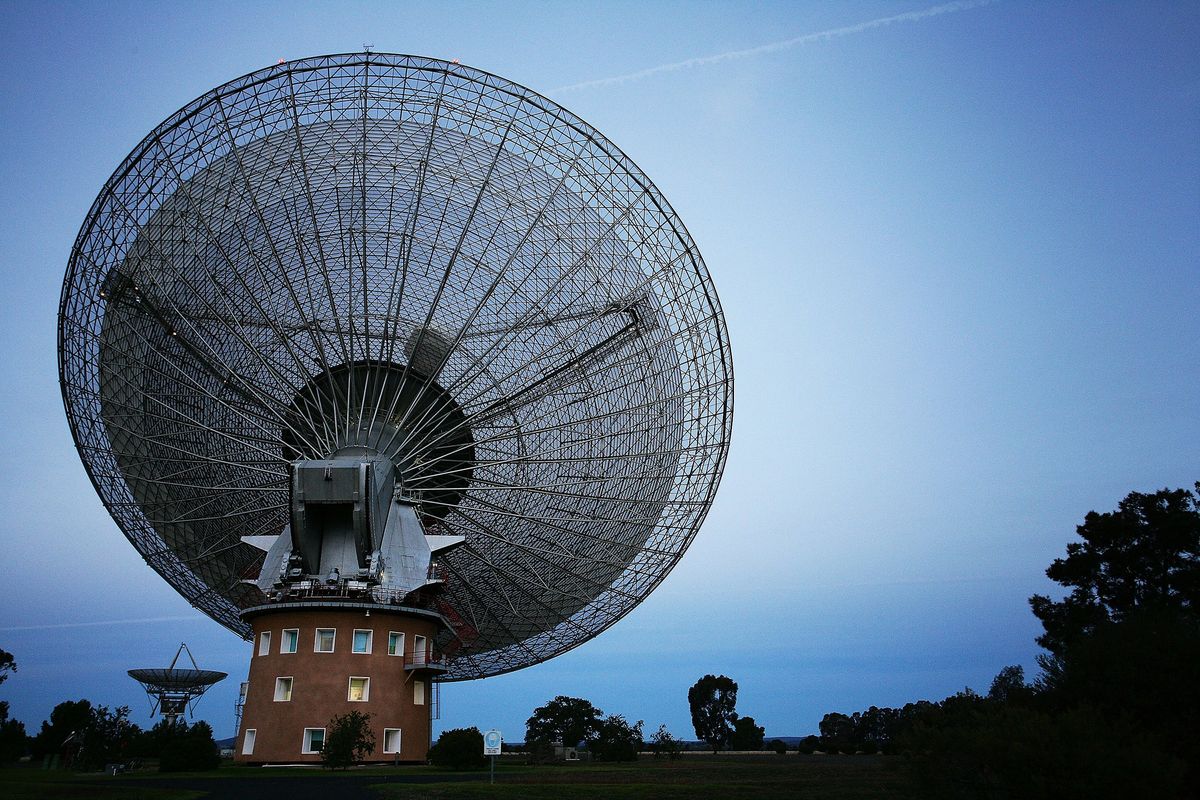Home>Devices & Equipment>Radio>Why Can’t We See Radio Waves


Radio
Why Can’t We See Radio Waves
Modified: January 22, 2024
Discover the invisible world of radio waves and learn why we can't see them. Explore how radio technologies work and their impact on communication and modern society.
(Many of the links in this article redirect to a specific reviewed product. Your purchase of these products through affiliate links helps to generate commission for AudioLover.com, at no extra cost. Learn more)
Table of Contents
Introduction
Radio waves have revolutionized the way we communicate and interact with the world around us. From the early days of radio broadcasting to the advanced technology of today’s wireless communication, radio waves have become an integral part of our daily lives. However, despite their significant impact, radio waves remain invisible to the human eye. Have you ever wondered why we can’t see radio waves?
To understand why radio waves are invisible, we need to delve into the world of electromagnetic radiation. Radio waves are a type of electromagnetic radiation, just like visible light, ultraviolet rays, and X-rays. The electromagnetic spectrum encompasses all forms of electromagnetic radiation, each with a specific range of frequencies and wavelengths.
Visible light comprises only a small portion of the electromagnetic spectrum. It spans from approximately 400 to 700 nanometers in wavelength, appearing as the colors we see in everyday life. The longer wavelengths beyond the red end of the visible spectrum, known as infrared, and the shorter wavelengths beyond the violet end, known as ultraviolet, are also invisible to the human eye.
The key difference between radio waves and visible light lies in their frequency and wavelength. Radio waves have much longer wavelengths, ranging from a few millimeters to thousands of kilometers. In contrast, the wavelengths of visible light range from about 400 to 700 nanometers, making them significantly shorter than radio waves.
Our eyes are sensitive to the wavelengths of visible light, as the cells in the retina, called rods and cones, can detect and interpret these wavelengths as colors. However, when it comes to radio waves, our eyes are simply not equipped to perceive them directly.
While we may not be able to see radio waves, their effects are all around us. From the radio signals that bring music and news into our homes, to the wireless networks that keep us connected, radio waves play a crucial role in modern communication technology. In the following sections, we will explore more about the nature of radio waves, why they are invisible to the human eye, and how we can detect and visualize their presence.
The Basics of Radio Waves
Radio waves are a form of electromagnetic radiation that were first discovered by James Clerk Maxwell in the 19th century. They are produced by accelerating electric charges, such as electrons, in an antenna. These accelerated charges create oscillating electric and magnetic fields, which propagate through space, carrying the information embedded in the radio wave.
Radio waves have varying frequencies and wavelengths, which determine their characteristics and applications. Frequency refers to the number of oscillations or cycles of the wave that occur per second, measured in Hertz (Hz). Wavelength represents the distance between two consecutive peaks or troughs of the wave, measured in meters (m).
The range of frequencies for radio waves is extensive, spanning from as low as a few kilohertz (kHz) to as high as hundreds of gigahertz (GHz). This wide range allows for different applications and uses of radio waves across various industries and technologies.
Radio waves are used for communication purposes. They can be modulated to carry audio signals, enabling radio broadcasting and two-way communication through devices such as walkie-talkies and cell phones. By encoding information onto the radio wave, we can transmit data wirelessly over long distances.
Additionally, radio waves have the ability to travel through obstacles such as walls and buildings, making them ideal for wireless communication. They can propagate over long distances, depending on their frequency and power, without the need for physical cables or wires.
It is important to note that radio waves are not only created by human-mediated processes but also occur naturally. For example, lightning produces radio waves as a result of electrical discharge in the atmosphere. Astronomical objects, such as stars and galaxies, also emit radio waves, providing valuable insights into the universe.
Understanding the basics of radio waves is crucial for comprehending how they interact with our environment, how they are harnessed for various applications, and why they remain invisible to the human eye. In the next section, we will explore the electromagnetic spectrum and the role of visible light in our perception of the world.
The Electromagnetic Spectrum
The electromagnetic spectrum is the range of all possible frequencies of electromagnetic radiation, including radio waves, visible light, ultraviolet rays, X-rays, and gamma rays. Each type of radiation in the spectrum has a distinct frequency range and wavelength, and they all share the same fundamental nature of oscillating electric and magnetic fields.
The electromagnetic spectrum is often represented as a continuum, with radio waves on one end and gamma rays on the other. The different regions of the spectrum are categorized based on their frequencies and wavelengths. While radio waves have the longest wavelengths and lowest frequencies, gamma rays have the shortest wavelengths and highest frequencies.
One of the most well-known portions of the electromagnetic spectrum is visible light. This is the range of electromagnetic radiation that our eyes are sensitive to, allowing us to perceive colors in our surroundings. Visible light consists of different colors, each corresponding to a specific wavelength. From longest to shortest wavelength, these colors are red, orange, yellow, green, blue, indigo, and violet, following the acronym ROYGBIV.
Human perception of colors depends on the wavelength of light that enters our eyes. When light hits an object, it interacts with the object’s surface and some of it is absorbed while the rest is reflected. The reflected light then enters our eyes, and the brain processes the information to give us the perception of color.
However, it’s important to note that visible light is just a narrow band within the entire electromagnetic spectrum. The wavelengths of visible light range from approximately 400 to 700 nanometers (nm), making it a small portion compared to radio waves, which range from millimeters to kilometers in wavelength.
Even though we often associate electromagnetic radiation with visible light, it’s crucial to understand that the spectrum extends far beyond what we can see. Other forms of electromagnetic radiation, such as radio waves, have longer wavelengths and lower frequencies than visible light.
In the upcoming section, we will explore why radio waves, despite being a part of the electromagnetic spectrum like visible light, are invisible to the human eye.
The Human Eye and Visible Light
The human eye is an incredibly complex and remarkable organ that allows us to perceive the world around us. It consists of several components, including the cornea, lens, iris, retina, and optic nerve. However, when it comes to perceiving electromagnetic radiation, our eyes are specifically designed to detect and interpret a narrow range of wavelengths known as visible light.
Visible light is just a small portion of the entire electromagnetic spectrum, with wavelengths ranging from approximately 400 to 700 nanometers. This range of wavelengths corresponds to the colors we observe in our everyday lives – from the red colors of sunsets to the vibrant greens of grass and the blues of the sky.
Within the eye, specialized cells called rods and cones play a crucial role in detecting and processing visible light. Rod cells are responsible for our vision in low-light conditions, providing us with black-and-white vision. Cone cells, on the other hand, enable us to perceive colors and fine details in bright light.
There are three types of cone cells in the human eye, each sensitive to a different range of wavelengths. One type is most sensitive to short-wavelength light, which corresponds to the color blue. The second type is most sensitive to medium-wavelength light, corresponding to the color green. The third type is most sensitive to long-wavelength light, corresponding to the color red.
When light enters the eye and strikes the photoreceptor cells in the retina, it triggers a series of chemical and electrical signals that are transmitted to the brain through the optic nerve. The brain then interprets these signals to create the visual perception of colors, shapes, and objects.
While our eyes are highly attuned to detecting and interpreting the wavelengths of visible light, they are not sensitive to other forms of electromagnetic radiation, such as radio waves. The wavelengths of radio waves are much longer than those of visible light, ranging from millimeters to kilometers. As a result, our eyes lack the ability to detect and process radio waves directly.
So, when it comes to why we can’t see radio waves, it ultimately boils down to the limitations of our visual system. Our eyes are simply not designed to perceive the longer wavelengths associated with radio waves. However, this does not diminish the importance and ubiquity of radio waves in our everyday lives, as we will explore in the following sections.
Why Radio Waves Are Invisible to the Human Eye
The visibility of electromagnetic radiation, including radio waves, is determined by the wavelengths that our eyes are sensitive to. While our eyes can detect and interpret the wavelengths of visible light, they are not equipped to perceive the longer wavelengths associated with radio waves.
As mentioned earlier, visible light spans a narrow range of wavelengths from approximately 400 to 700 nanometers. This specific range corresponds to the colors we observe in our everyday lives. Beyond the red end of the visible spectrum, longer wavelengths exist, which include the infrared region where remote controls and heat-sensing devices operate. Similarly, beyond the violet end of the spectrum, shorter wavelengths exist, which include the ultraviolet region where ultraviolet lamps and sunlight-induced skin damage occur.
Radio waves, on the other hand, have much longer wavelengths ranging from millimeters to kilometers. These longer wavelengths fall well beyond the range of our eyes’ sensitivity. The rods and cones in our retinas are not designed to detect or interpret electromagnetic radiation at these wavelengths, and therefore, we cannot see radio waves directly.
Another reason why we can’t see radio waves is due to the way different wavelengths of electromagnetic radiation interact with matter. In general, the interaction of electromagnetic waves with matter depends on the size of the object relative to the wavelength of the radiation. When the size of the object is much smaller than the wavelength, electromagnetic waves tend to pass through it with minimal interaction.
Visible light, with its shorter wavelength, interacts with molecules and atoms in our environment, leading to the phenomenon of absorption and reflection that determines the colors we perceive. Radio waves, with their much longer wavelengths, encounter fewer obstacles and can pass through objects like walls, buildings, and even the Earth’s atmosphere with ease. This property makes radio waves valuable for a wide range of applications, including wireless communication and radar systems.
While we may not be able to see radio waves directly, their effects are manifested in various ways. We can witness the impact of radio waves in the form of radio broadcasts, television signals, cellular networks, and Wi-Fi connections. Through antennas and receivers, we can convert these invisible radio wave signals into audio, video, and data that our eyes and other senses can perceive.
In summary, the invisibility of radio waves is a result of their longer wavelengths, which fall outside the range of our eyes’ sensitivity. Our visual system, evolved to detect and interpret the wavelengths associated with visible light, simply does not have the capability to see the longer wavelengths of radio waves. Nonetheless, the presence and impact of radio waves are undeniable in our modern world.
Detecting and Visualizing Radio Waves
Although we cannot see radio waves with our eyes, there are methods and tools available to detect and visualize their presence. Scientists and engineers have developed a range of devices and techniques to study and work with radio waves.
One essential device for detecting radio waves is the radio receiver. A radio receiver consists of an antenna that captures the incoming radio wave signals and converts them into electrical currents. These currents are then amplified and processed to retrieve the encoded information carried by the radio waves. Through this process, radio receivers allow us to listen to radio broadcasts, communicate using wireless devices, and access the vast array of information transmitted through radio waves.
Radar systems also rely on the detection and visualization of radio waves. Radar stands for “radio detection and ranging” and it works by emitting short pulses of radio waves and measuring the time it takes for the waves to bounce back after hitting an object. By analyzing the reflected waves, radar systems can determine the distance, speed, and direction of the objects. This technology is widely used in aviation, navigation, weather forecasting, and military applications.
In addition to these electronic devices, there are also visualization techniques employed to represent radio waves graphically. A common method is the use of spectrograms or frequency domain displays, which show the strength of different frequencies over time. These visual representations provide insights into the frequency content and patterns of radio wave signals.
Furthermore, radio telescopes are employed to study radio waves emitted by celestial objects. These large dish-shaped antennas capture the faint radio signals coming from distant stars, galaxies, and other celestial phenomena. By detecting and analyzing these radio waves, astronomers gain valuable information about the composition, temperature, and motion of objects in space.
Advancements in technology have also led to the development of software-defined radios (SDRs). SDRs allow users to capture and process radio waves using software algorithms, offering a flexible and versatile approach to working with radio signals. With SDRs, researchers, hobbyists, and engineers can experiment with different frequency bands and modulation methods to explore the world of radio waves.
Although we cannot perceive radio waves directly, these detection and visualization techniques enable us to understand, analyze, and utilize the invisible waves that surround us. From communication systems to scientific research, radio waves play a vital role in various fields of study and technological advancements.
Applications of Radio Waves
Radio waves have revolutionized the way we communicate, transmit data, and interact with technology. Their unique properties and ability to propagate through obstacles have led to a wide range of applications across diverse industries. Let’s explore some of the key applications of radio waves:
- Wireless Communication: Radio waves are the foundation of wireless communication. They enable us to make phone calls, send text messages, and access the internet through cellular networks. Wi-Fi technology also utilizes radio waves to establish wireless connections between devices, allowing for seamless internet access in homes, offices, and public spaces.
- Broadcasting and Entertainment: Radio broadcasting has been a popular medium for entertainment, news, and information dissemination for many decades. Radio stations use radio waves to transmit their signals, which are then received by radios and other devices equipped with radio receivers. Additionally, television broadcasts also rely on radio waves to transmit audio and video signals to our televisions.
- Radar Systems: Radar systems utilize radio waves to detect and track objects in various applications. These systems are widely used in aviation to aid in air traffic control, collision avoidance, and weather detection. They are also integral to military operations, maritime navigation, and meteorology for tracking storms, measuring distances, and providing crucial information for decision-making.
- Satellite Communication: Satellites play a pivotal role in global communication, and radio waves are the medium used to communicate with them. From satellite TV to GPS navigation systems, radio waves are utilized to establish communication links between ground-based devices and satellites orbiting the Earth. This enables seamless connectivity and data transfer across vast distances.
- Radio Astronomy: Radio waves provide astronomers with valuable insights into the universe. Radio telescopes are used to detect and study radio waves emitted by celestial objects. This form of astronomy helps scientists understand the structure, composition, and behavior of stars, galaxies, pulsars, and other cosmic phenomena, leading to groundbreaking discoveries.
- Medical Applications: Radio waves find applications in medical imaging and therapy. Magnetic resonance imaging (MRI) uses powerful radio waves and magnetic fields to create detailed images of the body’s internal structures. Radiofrequency ablation (RFA) is a medical procedure that uses radio waves to heat and destroy abnormal tissues, such as tumors.
- Home Automation and Internet of Things (IoT): The Internet of Things is rapidly expanding, connecting various devices within our homes and workplaces. Many IoT devices use radio waves to communicate with each other and with centralized systems. This enables us to control and monitor devices remotely, enhancing convenience, security, and energy efficiency.
These are just some of the many applications of radio waves that have transformed our lives. The versatility and reliability of radio waves in wireless communication, broadcasting, radar systems, astronomy, medical applications, and IoT continue to drive innovation and shape the future of technology.
Conclusion
Radio waves are a fascinating form of electromagnetic radiation that surrounds us, yet remains invisible to the human eye. While our eyes are designed to perceive the wavelengths of visible light, radio waves with their longer wavelengths fall beyond the range of our visual sensitivity. However, just because we can’t see radio waves doesn’t mean they don’t exist or lack significance.
Radio waves play a vital role in modern communication, allowing us to transmit information wirelessly, from radio broadcasting and wireless networks to satellite communication and radar systems. They penetrate through obstacles, making them ideal for long-distance communication and remote sensing applications.
Through various devices like radio receivers, radar systems, and radio telescopes, we can detect and interpret radio waves and derive valuable information from them. Spectrograms and visualization techniques enable scientists to analyze and understand the frequency content and patterns of radio wave signals.
The applications of radio waves are vast and diverse, encompassing wireless communication, broadcasting, radar systems, satellite communication, medical imaging, radio astronomy, and more. Radio waves have not only transformed the way we communicate and interact but have also opened doors to new scientific discoveries and technological advancements.
In conclusion, while we cannot see radio waves directly, their presence and impact are undeniable. The invisible waves that surround us have shaped our modern world and continue to drive innovation and connectivity. Understanding the nature of radio waves and their applications allows us to appreciate and harness their power for the betterment of society.











